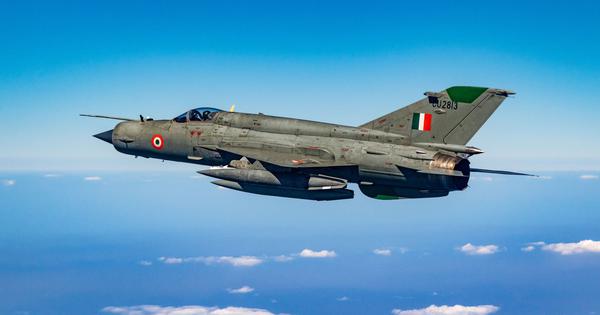
The Indian Air Force on Friday retired its famed Soviet-designed Mikoyan-Gurevich MiG-21 fighter jets after 62 years of service.
The aircraft, primarily designed to intercept and shoot down attacking enemy jets, quickly became the mainstay of the Air Force, even conducting ground-attack missions.
Over the decades, the IAF inducted more than 850 MiG-21s of several variants. Many of them were licence-built in India by Hindustan Aeronautics Limited. Some variants were gradually withdrawn over the years. The last type to retire was the upgraded Bison.
During the 1971 war, the MiG-21s bombed critical sites in East Pakistan and hastened the Pakistani military’s surrender. During the 1999 Kargil war, they were deployed to conduct air patrols and reconnaissance.
In 2019, a day after the Balakot air strike, a MiG-21 flown by fighter pilot Abhinandan Varthaman was among the jets scrambled to intercept Pakistani aircraft.
Despite serving the IAF well during conflicts, a series of fatal crashes in the early 2000s led the MiG-21 to be known as the “flying coffin”, or more inappropriately, the “widow maker”.
From the financial year 1971-’72 to April 2012, the last day for which official data is available, 171 pilots, several service personnel and 39 civilians were killed in 482 MiG-21 crashes and accidents.
The fatalities even formed the central plot of the 2006 Hindi language film Rang De Basanti as the protagonist’s fiancé, a MiG-21 pilot, is killed in a crash.
The high crash rate was attributed to mechanical failures linked to an aging airframe. But its outdated electronic systems had long made the Soviet-era jet obsolete.
This meant that the retirement was overdue.
While North Korea and some other countries still fly the MiG-21, the IAF was the last major air force to use it.
The gap laid bare
But it magnifies a major problem with which the IAF has to grapple. The withdrawal of the last two MiG-21 squadrons drops the IAF’s combat squadron strength to 29, against the 42 sanctioned in 2012. A fighting squadron typically has 16 to 18 jets.
This pressure on the Air Force’s frontline preparedness comes amid concerns that India may have to fight a “two-front war” and the military chief’s estimation that the next conflict “may happen soon”.
China is inducting two fifth-generation fighter aircraft it has developed – some of the most advanced stealth jets – in large numbers and Pakistan is preparing to procure them.
So while the Indian government postures that it has given impetus to defence production and procurement, the fall in squadron numbers to a level lower than it was during the 1965 war means that the IAF may be hard-pressed to meet its operational requirements.
This also provides another perspective to the high deaths attributed to the MiG-21. As former MiG-21 pilot Avinash Chikte has declared: “Airplanes do not make widows. Bureaucrats and politicians do – when they fail to replace aging fighters.”
Shoring up capabilities
In February, Air Force Chief AP Singh admitted that the IAF needs to induct 35 to 40 jets every year to make up for the shortage.
In line with the evolved threat perception, the IAF is reviewing the squadron strength ceiling to have more than 42.
Where will these come from?
The much-delayed Tejas Mk1A, a light combat aircraft, will start being delivered to the IAF next month. The initial order for 83 Tejas Mk1A jets was topped up with 97 more on Thursday. But the deliveries are expected to take several years because the manufacturer Hindustan Aeronautics Limited is dependent on engines imported from the United States.
This will be followed by the sizeable induction of the Tejas Mk2 over 10 years and the indigenous fifth-generation Advanced Medium Combat Aircraft by the middle of the next decade.
This will allow the IAF to not only fill the gap left by the MiG-21s, but also replace the aging Jaguars (three of which have crashed this year), the MiG-29s and the Mirage 2000 jets.
But the Tejas Mk2 and AMCA are still in development stages, the timelines are long and defence analysts are sceptical about the projects meeting their delivery deadlines.
In the interim, the IAF has reportedly proposed to shore up its capabilities by quickly purchasing 114 Rafales and a few squadrons of the Russian Su-57.
Here, it is pertinent to mention that in 2016, the Modi government had bought 36 Rafales instead of the 126 jets that were to be purchased.
Here is a summary of last week’s top stories.
Ladakh violence. Activist Sonam Wangchuk was arrested in Leh, two days after four persons were killed in police firing during protests seeking statehood for Ladakh. Wangchuk was taken into custody at about 2.30 pm on Friday when he was to address a press conference.
This came after the Union government alleged that Wangchuk’s “provocative statements” incited the violence on Wednesday. The protests demanding statehood for Ladakh and its inclusion in the Sixth Schedule of the Constitution that gives autonomy to tribal areas turned violent, with cases of arson and clashes with security forces.
On Thursday, the activist had said that he was not afraid of being arrested, but alleged that the authorities were making him a scapegoat. More than 50 people were detained and a curfew was imposed in Ladakh’s capital Leh. The authorities in Kargil and other major towns of the Union Territory also enforced prohibitory orders banning gatherings of five or more people.
The Foreign Contribution Regulation Act license of a non-governmental organisation run by Wangchuk was cancelled on Thursday.
How the government’s inaction on its promises on autonomy for Ladakh has fuelled frustration, writes environmentalist Ashish Kothari.
Defamation suits. The Supreme Court verbally observed that the time has come to decriminalise defamation. The court made the comment while hearing a petition against summons issued to The Wire in a defamation case filed by Amita Singh, a former professor at Jawaharlal Nehru University.
The petition was filed by the Foundation for Independent Journalism, which owns The Wire.
Section 356 of the Bharatiya Nyaya Sanhita criminalises defamation, which replaced the earlier provision on the offence under Section 499 of the Indian Penal Code.
In India, the provision has been used by politicians, individuals and businesses against journalists, rivals and media companies. Most democratic countries provide for civil remedy against the offence.
Trump’s tariffs. United States President Donald Trump announced a 100% tariff on the import of branded or patented pharmaceutical products, unless the company was building a manufacturing facility in the country. The policy, set to take effect from October 1, exempts companies that have begun construction on manufacturing facilities in the country.
India exported $8.7 billion worth pharmaceuticals to the US in 2024, but these are mostly generic products. Nonetheless, Indian pharmaceutical stocks fell 2.1% on Friday after the announcement.
While tariff on pharmaceuticals is not country-specific, Trump has already imposed so-called reciprocal tariffs on Indian goods and punitive levies for purchasing Russian oil.
Also on Scroll last week
Follow the Scroll channel on WhatsApp for a curated selection of the news that matters throughout the day, and a round-up of major developments in India and around the world every evening. What you won’t get: spam.
And, if you haven’t already, sign up for our Daily Brief newsletter.
📰 Crime Today News is proudly sponsored by DRYFRUIT & CO – A Brand by eFabby Global LLC
Design & Developed by Yes Mom Hosting






